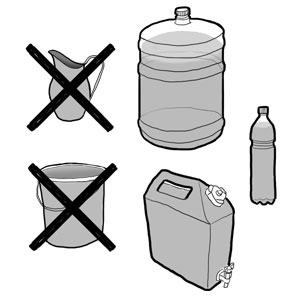Executive Summary
The health implications of inadequate water and sanitation services include an estimated 4 billion cases of diarrhoea and 1.9 million deaths each year, mostly among young children in developing countries (CDC & U.S. AID 2009). Safe storage and handling of water can reduce this health problem significantly. There are small volume storage possibilities such as cans, covered buckets or clay pots and tanks, large cistern and plastic tanks or even water towers, which supply a whole community with pressurised water. Costs depend on the system, buckets for instance are available almost everywhere. Large tanks, cisterns or towers need expert design. All these storage systems must be cleaned and inspected regularly to avoid health risks or damages.
| In | Out |
|---|---|
Freshwater, Drinking Water |
Introduction
Already treated or purified water has to be stored properly to prevent recontamination. Safe storage means keeping your treated water away from sources of contamination, and using a clean and covered container. It also means that drinking from the container should be done in a way that cross-contamination can be avoided. The container should prevent hands, cups and dippers from touching the water, so that the water does not get recontaminated (CAWST 2009). There are several possibilities to store water. They range from very small covered buckets to large tanks or cisterns. Another possibility is to store water in bottles. Furthermore, the hygienic conditions in a household are crucial. Good hygienic measures include the following (WHO 1997):
- Careful storage of household water and regular cleaning of all household water-storage facilities.
- Construction, proper use, and maintenance of latrines.
- Regular hand washing, especially after defecation and before eating, preparing food or handling drinking water.
- Careful storage and preparation of water and food.
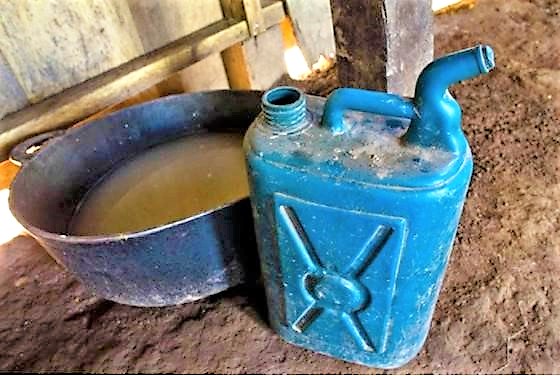
Treated water should be stored in plastic, ceramic, or metal containers especially when using treatment options that do not leave residual protection. The following characteristics of containers serve as physical barriers to recontamination (CDC & U.S. AID 2009):
- A small opening with a lid or cover that discourages users from placing potentially contaminated items such as hands, cups, or ladles into the stored water.
- A spigot or small opening to allow easy and safe access to the water without requiring the insertion of hands or objects into the container.
- A size appropriate for the household water treatment method, with permanently attached instructions for using the treatment method and for cleaning the container.
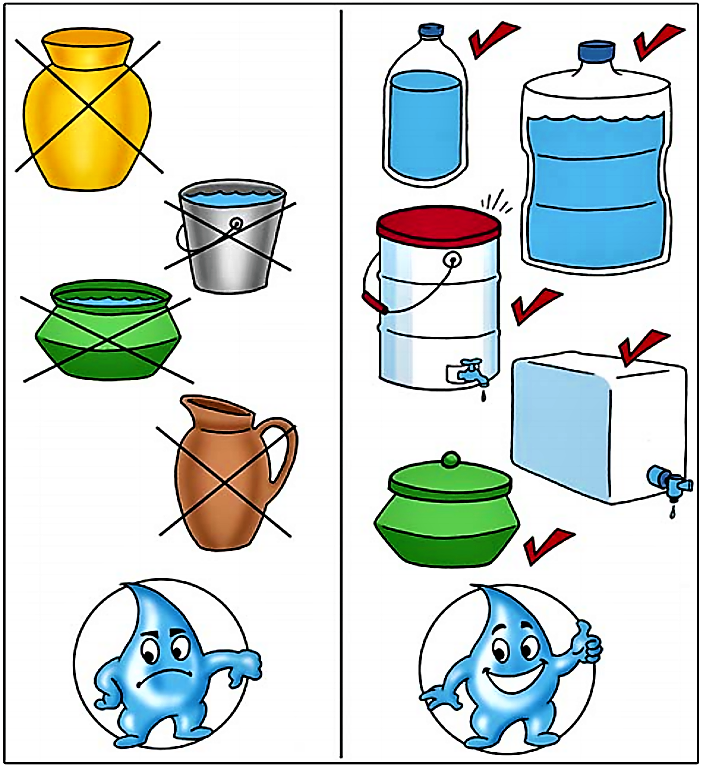
The following aspects should be considered when planning for safe storage and prevention of recontamination (WHO 1997):
- Location of storage vessel
- Design of storage vessel
- Removal of water
Basic design principles
Small-scale storage
The Oxfam bucket
The 14-litre Oxfam Bucket was designed to provide a safe storage option to organisations working on water safety in the home or refugee camps. It is manufactured in England, and sold unassembled to NGOs for use in programme implementation. The lids snap on to prevent entry of the hands or objects into the container. The Oxfam Bucket costs about US$11 (CDC & U.S. AID 2009; OXFAM 2012).
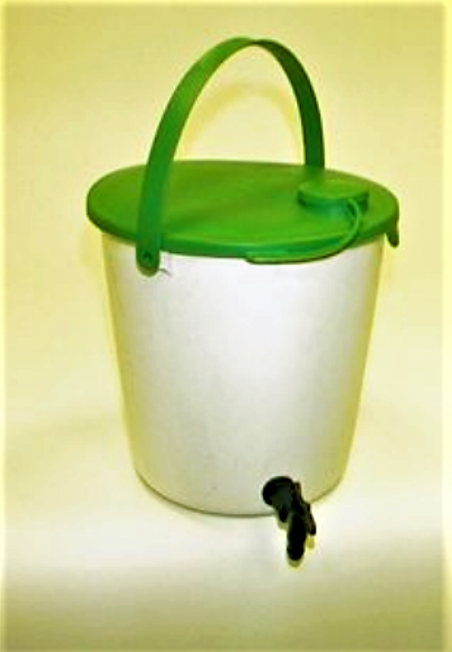
The CDC SWS container
In the initial Safe Water System (SWS) programmes, the CDC designed 20-litre modified jerry cans and provided them to users. This jerry can is now produced in Uganda, Afghanistan, Kenya, and the United States. Each jerry can costs approximately US$5, excluding transport (CDC 2012).
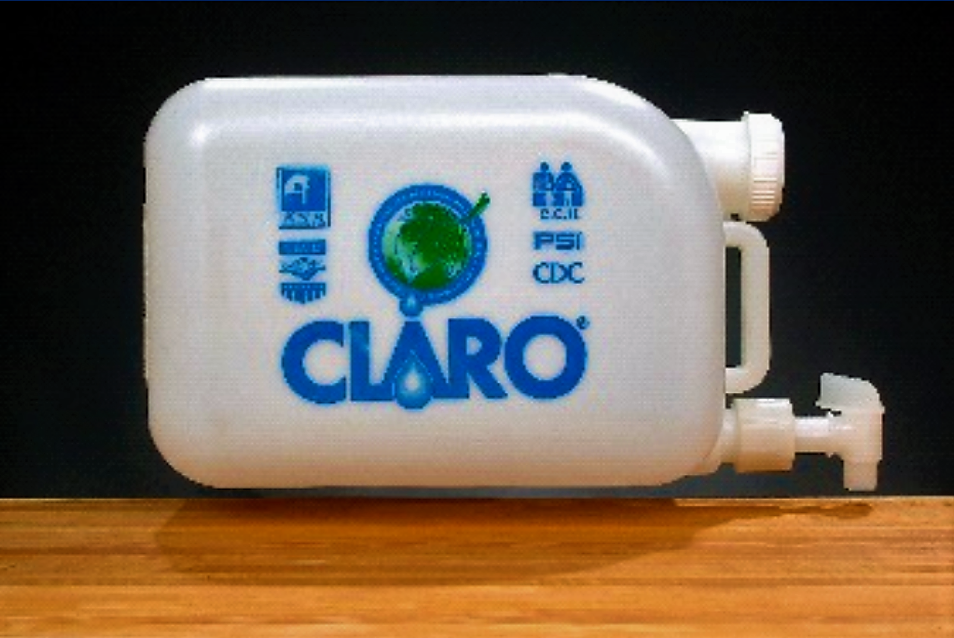
Jerry cans
In many countries in Africa, 20-litre jerry cans, initially used to transport vegetable cooking oils, are cleaned and used to transport and store water. They are easy to carry on the head (see also human powered distribution) and are a good option for safe storage. The opening is too small to allow hands or utensils into the water; instead the water is removed by pouring. Drilling a hole in the plastic and adding a tap provides easier access to the treated water and allows for a hand-washing station in the home. Used jerry cans cost approximately US$1-5 on the market in Africa (CDC & U.S. AID 2009).
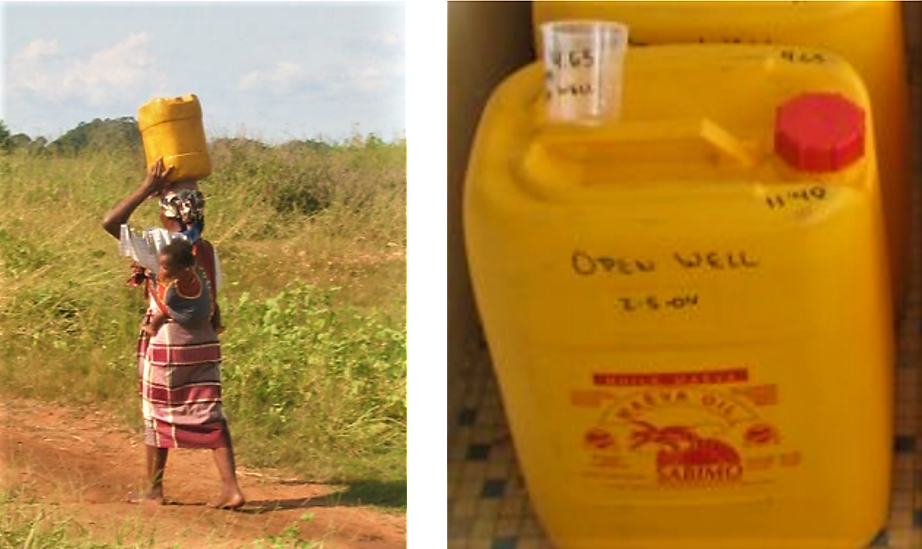
Bucket with lid and tap
Five gallon (19-litre) buckets are widely available in many countries and are often used for water transport and storage. Buckets can be modified for safe storage by ensuring the installation of a tight-fitting lid, or by drilling a hole through the plastic and installing a sturdy tap. Furthermore, a label with instructions for water treatment should be placed on the bucket, and people should be instructed to use the tap instead of dipping into the bucket. In Haiti, this is an easy educational message, since the tap is seen as a sign of higher socio-economic status, and families take pride in using it. Taps and labels can be imported or locally made (CDC & U.S. AID 2009).
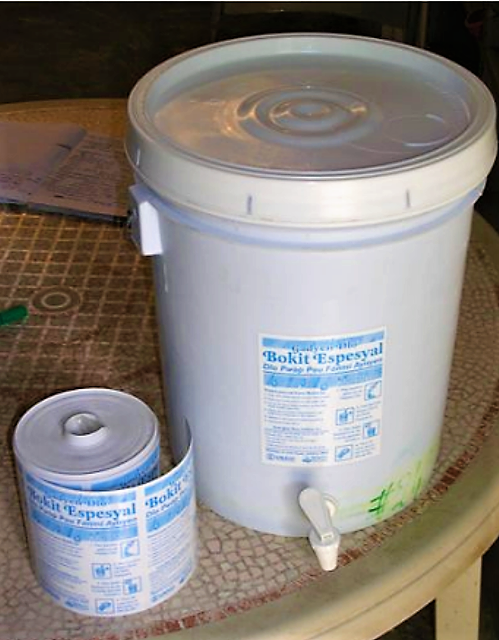
Modified clay pots
In many cultures, clay pots are the preferred storage container, because the water inside the container is cooled as water evaporates through the clay. In some rural areas, water is transported in clay pots, but in most areas water is transported in plastic containers and then stored in clay pots. By working with local potters, it is possible to modify clay pots to have a tap and an adequate cover, as seen in the two examples (CDC & U.S. AID 2009).
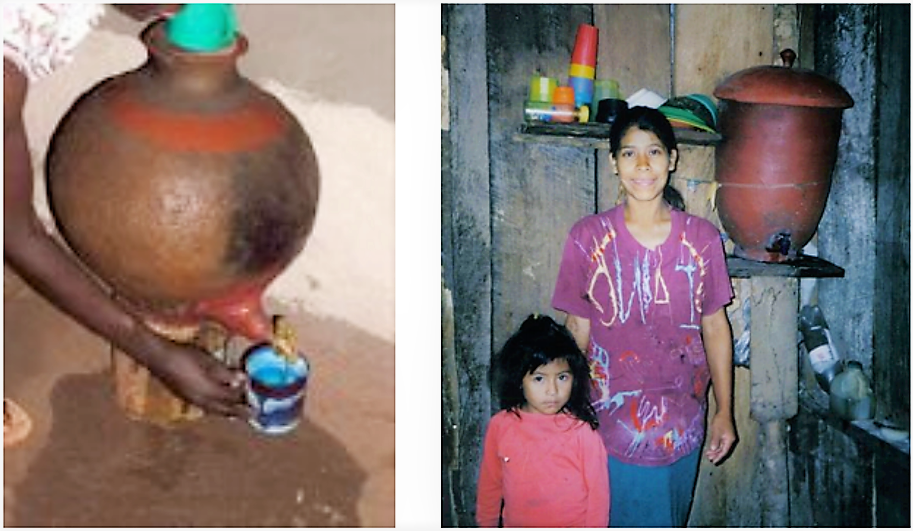
The Q-drum
In impoverished rural areas, clean water is often miles away from the people who need it, leaving them susceptible to waterborne diseases. The sturdy Q drum holds around 50 litres in a rolling container that eases the burden of transporting safe, potable water. One unit costs about US$60 (QDRUM 2011; VEGAS 2011). Also read the factsheet human powered distribution.
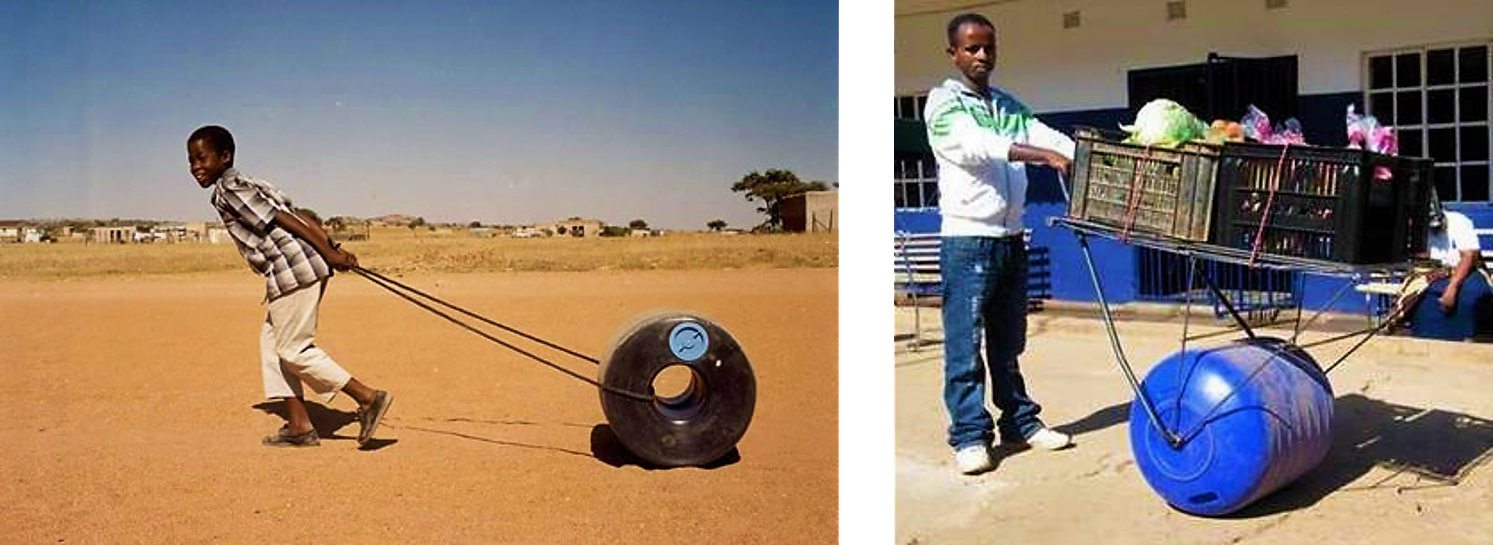
Large-scale storage
Large storage plastic tanks
For settlements in rural areas, large storage tanks are a possible solution if there is no connection to a water distribution network. They are either filled by tank trucks or by a rain water harvesting system. Plastic tanks are available in all sizes, from small to very large. It should be considered that they are UV stabilised, durable and impact resistant, impervious and made out of non-toxic material (e.g. food grade approved polyethylene) (PRACTICAL PLASTICS n.y.). Costs depend on manufacturer, country and size. The water in storage tanks should be tested regularly (UNHCR 2007).
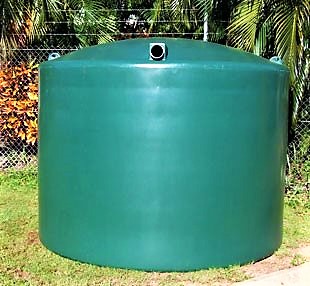
Cisterns
Adapted from ALI et al. (2009)
Two types of cisterns are common: single-cell and multi-cell. The choice of single or multiple cells depends on the rock and soil characteristics and the storage requirements. Cisterns of larger capacity (>300 m3) generally have more than one cell, while single-cell cisterns are smaller, usually built where soil and rock conditions do not allow for large capacity. A cistern has three main components: an inlet including a settling basin, a shaft (mouth and neck), and a storage chamber. The inlet allows runoff to enter the storage chamber, while the outlet allows excess water to flow out. The mouth opening facilitates withdrawal of water from the cistern, and is 50-75 cm in diameter. A wooden or steel grate covers the opening to prevent the entry of contaminants. The chamber is excavated in soft to medium soils underneath a layer of hard sedimentary rock, 0.5 metres to 2 metres thick, which forms a natural ceiling to the chamber. The inner sides of the chamber are plastered to minimise leakage. The chamber requires cleaning every four to five years if proper sediment traps are not provided. Generally, water is extracted from the cistern using buckets, although windmills, hand pumps or mechanised pumps are also used.
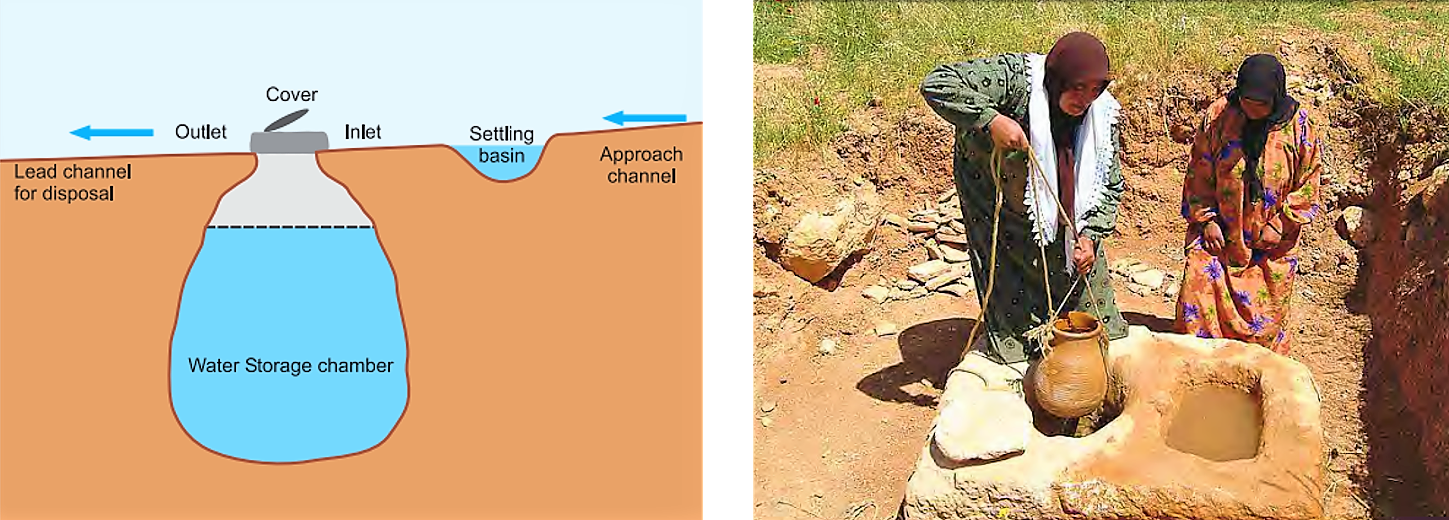
User experience shows that accumulated sediment must be removed from the cistern every 4 to 5 years, which adds to recurring maintenance costs. Soil erosion and debris/log flows from the catchment are the main sources of sediment. Flow concentration by water harvesting can increase sediment entry into the cistern. Steep slopes and weak soil structure in the catchment area also increase sediment production. Vegetation cover in the catchment area can reduce sediment, but also reduces runoff and may reduce water quality below drinking standard as shown in the factsheet on purification. Sediment can be reduced by treating problem spots in the catchments through compaction of loose patches, treatment with impermeable membranes, and breaking the steep land slopes. A sediment-settling basin immediately upstream of the entry point can significantly reduce sediment inflow. Furthermore, cisterns for domestic use and animals are separated from those for agriculture.
Towers
Adapted from BHARDWAJ & METZGAR (2001)
Water towers can be made of concrete or steel and can take various forms. The most suitable form for concrete towers is a cylinder with a curved shaped bottom or with a flat bottom. Steel tanks may have a spherical or dome shaped bottom. The shape chosen is usually a compromise between function, construction and maintenance costs, as well as aesthetics. The lowest water level in the tank is determined according to the pressure requirements in the pipeline. The pressure in the pipelines may vary depending on the type of community and pressure needs of different areas in a city. To keep pumping costs low, water depth in the tank is generally kept small. Due to structural considerations, the depth is kept equal to the diameter.
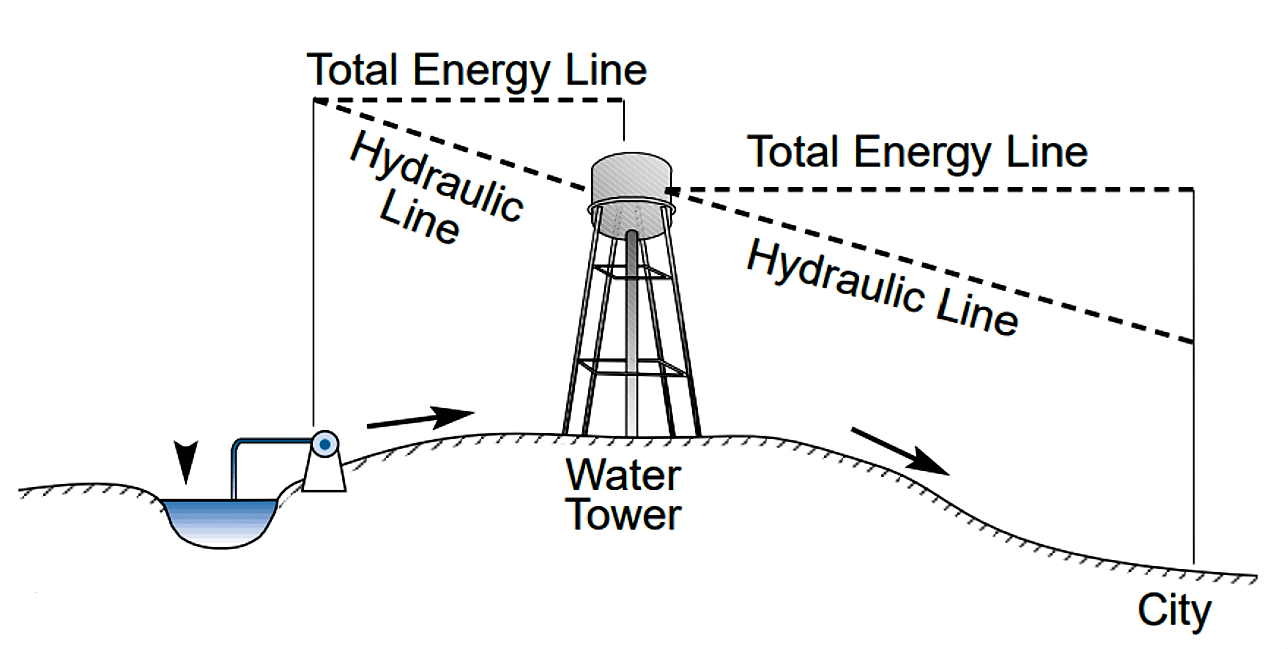
Cost considerations
The costs depend on the used storage system. Small-scale storage such as covered buckets or clay pots (see description above) can be very cheap. Large-scale methods, such as tanks, towers or cisterns need more technical supply and know-how (design, construction, material, pumps, etc.) and are very often owned by communities.
Health aspects
Storage for domestic and animal use and agricultural use must be strictly separated. An outlet such as a tap or a piping system should always be appropriately designed to prevent contact with hands or other sources of contamination, thus pouring treated water from the container rather than scooping the water out of it. Tanks, buckets or other storage types must be cleaned and flushed regularly to prevent health risks and recontamination. Purified water at household level should be used as soon as possible, preferably the same day, to minimise the risk of recontamination (CAWST 2009). In general, water from sources such as reservoirs, rainwater tanks, covered buckets or other water sources must be -purified before used as drinking water. It is also highly important to wash hands regularly, especially after defecation and before eating, preparing food and handling drinking water (WHO 1997).
Operation and maintenance
All the described storage accessories must be cleaned and inspected regularly. Biofilm, sedimentation, cracks, missing coverage, etc. are problems that might lead to a degeneration of water quality. Cleaning of storage tanks is especially important, if it held other contents before. This could be the case in an emergency (read more about this in GODFREY and REED 2011). The stored water should be tested regularly to ensure its quality.
| Working principle | Water is stored in small and covered buckets or containers, large tanks cistern or water towers. |
| Capacity/adequacy |
|
| Performance | High if kept clean and protected from contamination. |
| Costs | Depends on the storage capacity. |
| Self-help compatibility | Mostly high (except water towers). |
| O&M | Cleaning, inspection of accessories and monitoring of water quality. |
| Reliability | If well-constructed and maintained, potable water is available. |
| Main strength | Storage capacity can be fit to needs. |
| Main weakness | If the water source is contaminated, it must be purified before drinking. |
Small-scale water storage is mainly used where there is neither a distribution network nor motorised distribution. Small buckets can be carried by a single person and it is handy to work with it in the household. Bigger tanks (or cisterns), which are filled by a tank truck or a rainwater harvesting system, are applied in single households or communities. Water towers are mainly used for communities and to create enough pressure to distribute the water via a piped network.
Rainwater Cisterns. Traditional Technologies for Dry Areas
Rainwater cisterns are indigenous underground water storage structures, widely used in the Matrouh area in north-western Egypt, in steppe areas in Syria and Jordan, and elsewhere. Little information is available on the design, construction and operation of traditional cisterns. Most available publications on water cisterns deal with rooftop water harvesting, using pre-fabricated materials. These cisterns are of very limited capacity (a few cubic meters) and are more expensive than underground cisterns. Most publications on rainwater harvesting are written for water professionals and researchers, not for local users and development practitioners. This publication responds to the needs expressed by water users, and especially ICARDA’s research and development partners. It will also be useful to policy makers responsible for water development in dry areas.
ALI, A., OWEIS, T., SALKINI, A.B. and EL-NAGGAR, S. (2009): Rainwater Cisterns. Traditional Technologies for Dry Areas. Aleppo: International Center for Agricultural Research in the Dry Areas (ICARDA) URL [Accessed: 13.03.2019] PDFReservoirs, Towers, and Tanks - Drinking Water Storage Facilities
After water leaves the treatment plant and before it reaches the customer, it must be adequately and safely stored. This tech brief explores the various aspects of water storage
BHARDWAJ, V. METZGAR, C. (2001): Reservoirs, Towers, and Tanks - Drinking Water Storage Facilities. (= Factsheet ). Morgantown: National Drinking Water Clearinghouse (West Virginia University) URL [Accessed: 02.04.2012]An Introduction to Household Water Treatment and Safe Storage, A CAWST Training Manual
This training manual describes the need of safe drinking water and sanitation and provides relevant information on HWTS process, technologies. It is good reference material for trainers to conduct training on HWTS.
CAWST (2009): An Introduction to Household Water Treatment and Safe Storage, A CAWST Training Manual. Calgary: Centre for Affordable Water and Sanitation Technology (CAWST) URL [Accessed: 13.05.2019]The CDC SWS Container
Preventing Diarrheal Disease in Developing Countries: Safe Storage of Drinking Water
This factsheet summarises the health problems, which are created by contaminated water and gives you an overview of small-scale water storage options.
CDC ; U.S. AID (2009): Preventing Diarrheal Disease in Developing Countries: Safe Storage of Drinking Water. Atlanta and Washington D.C.: Centers for Disease Control and Prevention (CDC) and U.S. Aid. Publisher URL [Accessed: 29.03.2012]Cleaning and Disinfecting Water Storage Tanks and Tankers. Technical Notes on Drinking-Water, Sanitation and Hygiene in Emergencies
In an emergency situation, it is often necessary to quickly provide a basic water supply for the affected population. This may be because the normal systems of supply have been damaged or destroyed. The most common, immediate solution is to hire vehicles and tanks that have been used for other purposes or to retrieve collapsible tanks from an emergency store. In either case, they must be cleaned and disinfected before being used. This technical note outlines a four-step approach to cleaning and disinfecting water tanks and tankers.
GODFREY, S. REED, B. (2011): Cleaning and Disinfecting Water Storage Tanks and Tankers. Technical Notes on Drinking-Water, Sanitation and Hygiene in Emergencies. Geneva: World Health Organisation (WHO) URL [Accessed: 02.04.2012]The Effectiveness of Large Household Water Storage Tanks for Protecting the Quality of Drinking Water
This study evaluated changes in drinking water quality resulting from an intervention that provided large closed water storage tanks (2,500-gallons) to individual homes lacking a piped water supply.
GRAHAM, J.P. ; VANDERSLICE, J. (2007): The Effectiveness of Large Household Water Storage Tanks for Protecting the Quality of Drinking Water. In: Journal of Water and Health: , 307-313. URL [Accessed: 22.05.2019]Q Drum: Water Transportation Made Easier
Product Catalogue
This brochure gives an overview of the large assortment of water storage plastic tank products.
PRACTICAL PLASTICS (n.y): Product Catalogue. Darwin: Practical Plastics Ltd URL [Accessed: 22.05.2019]The Rollable Water Container for Developing Countries
Handbook for Emergencies. Third Edition
This extensive handbook from the UN High Commissioner for Refugees (UNHCR) on emergency responses reflects the multiple dimensions of an emergency response, ranging from emergency management to emergency operations and their support. The handbook mainly looks at emergencies where populations have been displaced from their former living environment.
UNHCR (2007): Handbook for Emergencies. Third Edition. Geneva: UNHCR Emergency Preparedness and Response Section URL [Accessed: 21.05.2019]Brilliant Eco Inventions: Big Ideas, Small Packages
Guidelines for Drinking-water Quality. Second Edition, Volume 3
This volume of Guidelines for drinking-water quality describes the methods employed in the surveillance of drinking-water quality in the light of the special problems of small-community supplies, particularly those of developing countries, and outlines the strategies necessary to ensure that surveillance is effective. It is also concerned with the linkage between surveillance and remedial action and with the form that remedial action should take.
WHO (1997): Guidelines for Drinking-water Quality. Second Edition, Volume 3. Surveillance and Control of Community Supplies. Geneva: World Health Organization (WHO) URL [Accessed: 04.04.2012]Rainwater Cisterns. Traditional Technologies for Dry Areas
Rainwater cisterns are indigenous underground water storage structures, widely used in the Matrouh area in north-western Egypt, in steppe areas in Syria and Jordan, and elsewhere. Little information is available on the design, construction and operation of traditional cisterns. Most available publications on water cisterns deal with rooftop water harvesting, using pre-fabricated materials. These cisterns are of very limited capacity (a few cubic meters) and are more expensive than underground cisterns. Most publications on rainwater harvesting are written for water professionals and researchers, not for local users and development practitioners. This publication responds to the needs expressed by water users, and especially ICARDA’s research and development partners. It will also be useful to policy makers responsible for water development in dry areas.
ALI, A., OWEIS, T., SALKINI, A.B. and EL-NAGGAR, S. (2009): Rainwater Cisterns. Traditional Technologies for Dry Areas. Aleppo: International Center for Agricultural Research in the Dry Areas (ICARDA) URL [Accessed: 13.03.2019] PDFReservoirs, Towers, and Tanks - Drinking Water Storage Facilities
After water leaves the treatment plant and before it reaches the customer, it must be adequately and safely stored. This tech brief explores the various aspects of water storage
BHARDWAJ, V. METZGAR, C. (2001): Reservoirs, Towers, and Tanks - Drinking Water Storage Facilities. (= Factsheet ). Morgantown: National Drinking Water Clearinghouse (West Virginia University) URL [Accessed: 02.04.2012]An Introduction to Household Water Treatment and Safe Storage, A CAWST Training Manual
This training manual describes the need of safe drinking water and sanitation and provides relevant information on HWTS process, technologies. It is good reference material for trainers to conduct training on HWTS.
CAWST (2009): An Introduction to Household Water Treatment and Safe Storage, A CAWST Training Manual. Calgary: Centre for Affordable Water and Sanitation Technology (CAWST) URL [Accessed: 13.05.2019]Preventing Diarrheal Disease in Developing Countries: Safe Storage of Drinking Water
This factsheet summarises the health problems, which are created by contaminated water and gives you an overview of small-scale water storage options.
CDC ; U.S. AID (2009): Preventing Diarrheal Disease in Developing Countries: Safe Storage of Drinking Water. Atlanta and Washington D.C.: Centers for Disease Control and Prevention (CDC) and U.S. Aid. Publisher URL [Accessed: 29.03.2012]Cleaning and Disinfecting Water Storage Tanks and Tankers
The most common, immediate solution to quickly provide a basic water supply in an emergency is to hire vehicles and tanks that have been used for other purposes or to retrieve collapsible tanks from an emergency store. This technical note outlines a four-step approach to cleaning and disinfecting water tanks and tankers.
GODFREY, S. REED, B. (2013): Cleaning and Disinfecting Water Storage Tanks and Tankers. (= Technical Notes on Drinking-Water, Sanitation and Hygiene in Emergencies , 3 ). Geneva: World Health Organization (WHO) URL [Accessed: 26.08.2013]The Effectiveness of Large Household Water Storage Tanks for Protecting the Quality of Drinking Water
This study evaluated changes in drinking water quality resulting from an intervention that provided large closed water storage tanks (2,500-gallons) to individual homes lacking a piped water supply.
GRAHAM, J.P. ; VANDERSLICE, J. (2007): The Effectiveness of Large Household Water Storage Tanks for Protecting the Quality of Drinking Water. In: Journal of Water and Health: , 307-313. URL [Accessed: 22.05.2019]Household Water Treatment and Safe Storage Options in Developing Countries. Review of Current Implementation Practices
Summary and brief evaluation of the main household water treatment and safe storage (HWTS) options for developing countries. Treated options are: chlorination, biosand filtration, ceramic filtration, solar disinfection, filtration and chlorination, flocculation and chlorination.
LANTAGNE, D. S. ; QUICK, R. ; MINTZ, E.D. (2006): Household Water Treatment and Safe Storage Options in Developing Countries. Review of Current Implementation Practices. In: Woodrow Wilson International Center for Scholars (2006): Water Stories: Expanding: Opportunities in small-scale Water and Sanitation Projects: , 17-38. URL [Accessed: 19.05.2019]Household Water Storage, Handling and Point-of-Use Treatment
This review carefully summarises the growing body of research on storing, handling and treating water in the home. In doing so, it builds on the pioneering report on household water management prepared by professor Mark Sobsey for the World Health Organisation (WHO). It provides compelling evidence that interventions to improve the microbial quality of water at the point of use are as effective as other environmental measures, such as hygiene and sanitation, in preventing diarrhoeal disease.
NATH, K.J. BLOOMFIELD, S. JONES, M. (2006): Household Water Storage, Handling and Point-of-Use Treatment. Somerset (UK): International Scientific Forum on Home Hygiene (IFH) URL [Accessed: 02.04.2012]Product Catalogue
This brochure gives an overview of the large assortment of water storage plastic tank products.
PRACTICAL PLASTICS (n.y): Product Catalogue. Darwin: Practical Plastics Ltd URL [Accessed: 22.05.2019]Rainwater Tanks: Maintenance and Water Care
In Australia where water is scarce, the limited rainfall is too valuable to waste. Rainwater is generally safe to drink but collecting a good, clean supply depends on “low maintenance — not no maintenance”. Read more about it here.
SA HEALTH (2008): Rainwater Tanks: Maintenance and Water Care. Adelaide: Department of Health, Government of South Australia URL [Accessed: 22.05.2019]Handbook for Emergencies. Third Edition
This extensive handbook from the UN High Commissioner for Refugees (UNHCR) on emergency responses reflects the multiple dimensions of an emergency response, ranging from emergency management to emergency operations and their support. The handbook mainly looks at emergencies where populations have been displaced from their former living environment.
UNHCR (2007): Handbook for Emergencies. Third Edition. Geneva: UNHCR Emergency Preparedness and Response Section URL [Accessed: 21.05.2019]Guidelines for Drinking-water Quality. Second Edition, Volume 3
This volume of Guidelines for drinking-water quality describes the methods employed in the surveillance of drinking-water quality in the light of the special problems of small-community supplies, particularly those of developing countries, and outlines the strategies necessary to ensure that surveillance is effective. It is also concerned with the linkage between surveillance and remedial action and with the form that remedial action should take.
WHO (1997): Guidelines for Drinking-water Quality. Second Edition, Volume 3. Surveillance and Control of Community Supplies. Geneva: World Health Organization (WHO) URL [Accessed: 04.04.2012]Combating Waterborne Diseases at the Household Level
This document is divided into three main parts. The first part contains an introduction to the topic and depicts some possible, simple techniques for treating water at the household level. The second part describes the possibility of collaborating to fight against waterborne diseases and the last part presents again some low-cost solutions.
WHO (2007): Combating Waterborne Diseases at the Household Level. The International Network to Promote Household Water Treatment and Safe Storage. Geneva: World Health Organisation (WHO) URL [Accessed: 11.10.2010]Toolkit for monitoring and evaluating household water treatment and safe storage
In order to develop effective mechanisms to encourage and sustain correct use of household water treatment and safe storage (HWTS), there is a need to monitor and evaluate uptake. The Toolkit provides an overall framework for this. One of the key features is the presentation of 20 harmonized, global indicators to assess correct and consistent use of household water treatment and safe storage by those most at risk.
WHO ; UNICEF (2012): Toolkit for monitoring and evaluating household water treatment and safe storage. Geneva: World Health Organization URL [Accessed: 08.11.2012]Conservation et Traitement de l Eau a Domicile
This practical guide provides a review of different processing techniques and adequate water conservation at home and is structured around 10 key questions that should be posed before choosing a suitable solution.
DESILLE, D. (2013): Conservation et Traitement de l Eau a Domicile. Paris: Programme Solidarite Eau (PSeau) URL [Accessed: 06.06.2013]Q-Drum - low cost rollable water container
Check out the movie about this low cost rollable water container for developing countries

